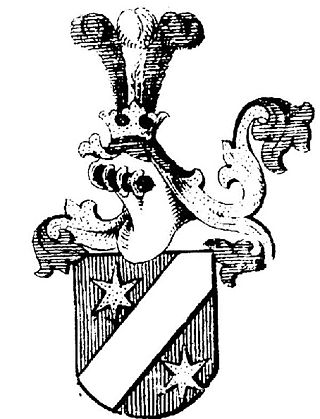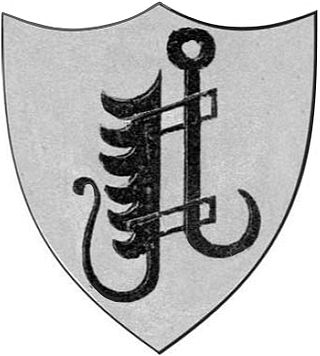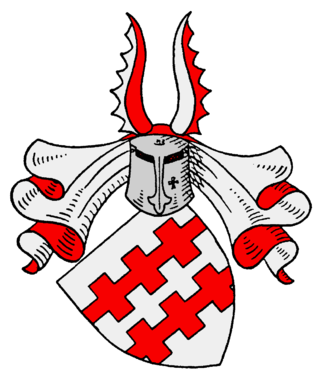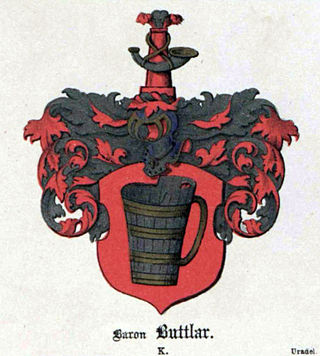
Freiherr, Freifrau and Freiin are designations used as titles of nobility in the German-speaking areas of the Holy Roman Empire and in its various successor states, including Austria, Prussia, Bavaria, Liechtenstein, Luxembourg, etc. Traditionally, it denotes the titled rank within the nobility above Ritter (knight) and Edler and below Graf. The title superseded the earlier medieval form, Edelherr.

Nassau is a town located in the German state of Rhineland-Palatinate. It lies on the lower course of the Lahn River, on the mouth of the Mühlbach, between Limburg an der Lahn and the spa town of Bad Ems, and is located in the Nassau Nature Park, surrounded by the Westerwald to the north and the Taunus to the south. The town is on the German-Dutch holiday road, the Orange Route. As of 2021, it had a population of 4,592.

Reventlow is the name of a Holstein and Mecklenburg Dano-German noble family, which belongs to the Equites Originarii Schleswig-Holstein. Alternate spellings include Revetlo, Reventlo, Reventlau, Reventlou, Reventlow, Refendtlof and Reffentloff.

The Military Order of Maria Theresa was the highest military honour of the Habsburg monarchy, Austrian Empire and Austro-Hungarian Empire.

The House of Fürstenberg is the name of a German noble family of Westphalia, which descended from Hermannus de Vorstenberg. He was a liegeman of the Archbishop of Cologne, who was among the prince electors of the Holy Roman Empire. Hermannus held a castle for his lord called Fürstenberg at Ense-Höingen in Soest; this castle would give the family its name. His son was Wilhelm von Vorstenberg, the Justiciar and Castellan of Werl.

Runkel is a town on the river Lahn in Limburg-Weilburg district in Hesse, Germany.

Molsberg is an Ortsgemeinde – a community belonging to a Verbandsgemeinde – in the Westerwaldkreis in Rhineland-Palatinate, Germany.

Raitz von Frentz is the name of a baronial (freiherrlichen) family, that belongs to the German ancient nobility (Uradel). The Barons Raitz von Frentz should be distinguished from the dynastic family "von Frenz", a branch of the Dukes of Limburg, that became extinct in the 14th century.

Weber is the surname of an aristocratic German Catholic family from Bavaria. Originating in Upper Franconia, the male line originates with Friedrich Weber, huntsman of the Prince Bishop of Bamberg, as well as mayor of Marktleugast.

The House von der Decken is the name of an old Hanoverian family of German nobility. Since more than 750 years the center of the family is in a part of Lower Saxony at the south bank of the river Elbe called Kehdingen.

Merveldt is the name of a Westphalian noble family, which belongs to the nobility of the Middle Ages. The Herrn [Lords] von Merveldt were among the oldest families in the Münsterland. Merfeld, the eponymous seat of the family, is now a neighborhood of the city of Dülmen in the District of Coesfeld in the state of North Rhine-Westphalia in Germany.

Arenstorff, also Arnstorff, is the name of a German family in the ancient nobility of Brandenburg from the Uckermark.

Runkel Castle, a ruined hill castle from the High Middle Ages, is located in the city of Runkel in the Landkreis of Limburg-Weilburg in the state of Hesse.

The House of Sickingen is an old southwest German noble family. The lords of Sickingen belonged to the Kraichgau nobility and from 1797 to the Imperial nobility. Significant relatives emerged from the family, who achieved great influence in both spiritual and secular offices. Reinhard von Sickingen was Prince-Bishop of Worms from 1445 to 1482 and Kasimir Anton von Sickingen was Prince-Bishop of Constance from 1743 to 1750. Imperial Knight Franz von Sickingen (1481-1523) was a leader of the Rhenish and Swabian knighthood.

Pranckh is the name of an ancient Austrian noble family, descending from Pranckh Castle, near Sankt Marein bei Knittelfeld in the former March and later Duchy of Styria. The family's origins date back to the year 1135, when Wolfkerus de Branka attested a charter regarding an endowment to Admont Abbey, thus making it one of the oldest families in Austria still present today. In addition to the Styrian mainline, other branches existed in Salzburg, Carinthia, Lower Austria and Bavaria. In later parts of history, the family rose from Knights to Reichsfreiherren (Barons of the Holy Roman Empire) and Reichsgrafen (Imperial Counts of the Holy Roman Empire). Many of their names can be found in high court and state offices of the Archbishopric of Salzburg. Branches of the family exist to this day in Austria, Germany, France and the United States.

The House of Buttlar is the name of an old Upper Franconian-Hessian noble family. The lords of Buttlar originate from the ancient nobility of Buchonia. Branches of the family also reached Westphalia, Saxony, Prussia, Curonia, France, Poland, Russia and Hungary, and remain partly to this day. The Buttlar and Treusch von Buttlar families of Hessen has since 1660 belonged to the Old Hessian Knighthood, the oldest foundation in Hessen.

The House of Kotzebue was a Baltic German noble family of Brandenburgish origin, tracing its origin back to Kossebau in Altmark. They held nobility status in the Russian Empire and the Kingdom of Bavaria. The English name of the Alaskan Inuit city of Kotzebue, as well as the neighboring Kotzebue Sound, in the Alaskan Arctic take their names from Otto von Kotzebue, a Russian naval officer of this family.

Oskar Freiherr von Zoller was a Bavarian Lieutenant general who was known for serving at the Battle of Kissingen during the Austro-Prussian War, being killed during the fighting.

The House of Poschinger is an ancient Bavarian noble family. Its origin date back to the year 1140. The family received the rank of Knights of the Holy Roman Empire. The Frauenau branch rose to the rank of Barons (Freiherr) in the Kingdom of Bavaria and held a hereditary seat in the House of Councillors.

Sandizell is the name of an old Bavarian noble family. The Lords of Sandizell belong to the old Bavarian nobility. Branches of the family exist to this day.
1 High jumping ↑ Tageblatt St. Gallen of 13 October 2012: The Legacy of Luxburg, accessed on 16 October 2012





















